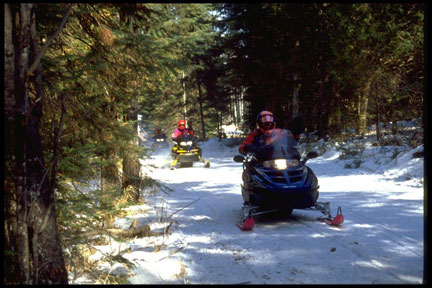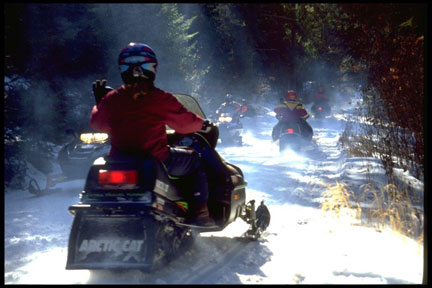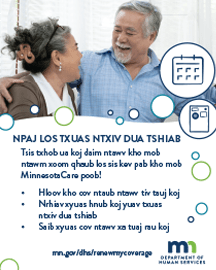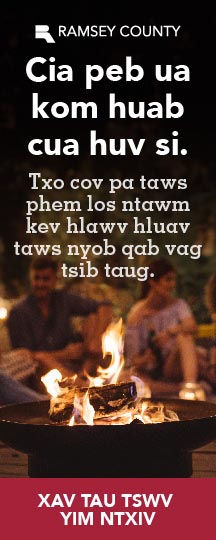Snowmobiling – Like A Sledding Hill That Just Goes On And On
By Harland Hiemstra, DNR INformation Officer
If you’ve ever enjoyed the rush of sledding down a steep, snowy hill only to wish the slope went on forever and you didn’t have to walk back up to do it again, you might want to look into snowmobiling, one of Minnesota’s most popular outdoor winter activities.
“It’s a great way to get out in nature and see a lot of beautiful areas you might not otherwise be able to see,” says Andrew Korsberg, snowmobile program consultant for the Minnesota Department of Natural Resources. “It’s also just a great way to spend time with family and friends.”
Minnesota has the most extensive snowmobile trail system in the country, with about 22,000 miles of groomed trails. That’s more than the miles of state and federal highways we have! In a year with plenty of snow, a rider could, theoretically, ride a snowmobile from Iowa to the Canadian border.
The extent of Minnesotans’ enthusiasm for snowmobiling is reflected in the fact that 21,300 miles of those snowmobile trails are largely managed and maintained by volunteers affiliated with more than 200 local snowmobiling clubs all across the state. The DNR oversees a grant program that provides much of the funding for their maintenance and grooming work, and it offers technical assistance and other support. The remaining 700 miles are state trails maintained and groomed by the DNR.
That trail system provides the backbone for much of the winter tourism in the state. According to the Minnesota United Snowmobile Association, the total economic impact of snowmobiling in Minnesota is an estimated $1 billion each year. Two of the four major snowmobile manufacturers, Polaris and Arctic Cat, started in Minnesota and remain based in the state.
Getting started in snowmobiling can involve some upfront investment, with the cost of a new sled running about $10,000 – 15,000. But used sleds can be found for as little as $2,000. If you want to try before you buy, a quick online search will turn up a number of rental opportunities spread around the state. In addition to the machine itself, you’ll need proper cold-weather gear: well insulated snow pants and coat, mittens or gloves, warm boots. A helmet is not required, but it’s a good idea for safety and, with the addition of a balaclava worn inside the helmet, is a smart way to keep your head from getting cold. Staying warm is a critical factor in having any kind of outdoors fun during a Minnesota winter!
As important as having the right equipment is, you also need to know how to use it safely and legally. Minnesota law requires anyone born after December 31, 1976, to complete a snowmobile safety course, online or in-person (youth ages 11 to 15 must complete at least part of their training in-person). Go the DNR’s website at www.mndnr.gov and search for “snowmobile safety” to get more details.
Capt. Jason Peterson, a regional enforcement supervisor for the DNR, stresses the importance of using common sense to remain safe while having fun on a snowmobile. Don’t go too fast, especially at night. Be cautious when riding on frozen waters; there should be at least seven inches of clear ice – and no ice is ever 100 percent safe. Don’t drink while riding – it’s not only dangerous, it can lead to the same legal consequences as a DWI.
Peterson also emphasizes that all snowmobiles operated in Minnesota must be registered. Registration fees provide funding for the trails system, he notes, so it’s not only the law, it’s a matter of pitching in to help pay for the opportunity to ride all around the state.
Some of the most scenic riding opportunities in Minnesota are in the northeast part of the state. The North Shore State Trail, for instance, runs 146 miles from Duluth to Grand Marais, winding its way through forests on the ridgeline overlooking Lake Superior. The Taconoite Trail, running from Grand Rapids to Ely, is another favorite. And many people enjoy riding the trails in the Brainerd lakes area, as well as around Lake Mille Lacs.
Since adequate snow is critical to good snowmobiling, it’s smart to check local conditions for your planned destination before loading up and heading out. The DNR website includes an interactive map that provides information on snow depths around the state; it’s updated weekly on Thursdays. Go to www.mndnr.gov and search “current conditions.”
DNR’s website also features trail maps that can be downloaded to a GPS device, so that you can keep track of where you are and where you’re going. A GPS device also is useful for making sure one stays on designated trails. That’s important because much of the statewide trail system crosses private land, and it’s critical to maintain good relations with landowners if they’re to continue allowing access.
So, if the prospect of another two or three months of cold and snow has you feeling down, consider getting in winter’s face on the back of a snowmobile. It might just provide you with a new way to spell F-U-N!







